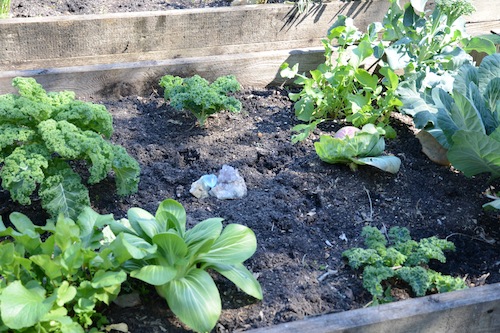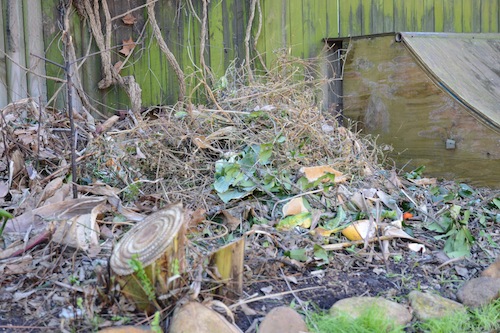Composting Under the Snow Moon
Winter is a fun time to compost because you can really see the result of your labor. Well, really the labor of the microbes, but you are the one braving the cold to get out there adding and tending the pile! Winter is when you actually get to see the steam rising from your pile. I think this visual cue is so rewarding! You finally know your pile is hot enough!
I know, I know my pile is in FL and those of you in the snow don’t want to hear it! But I am in north Florida! Although there is no snow, it freezes here and we have seen temps in the teens this winter. You can see I have plenty of “brown” in my pile currently thanks to all those freezing nights! My pile doesn’t get anywhere close to as much sun as I wish it did to warm it up in winter, but it is in a protected area of the backyard so at least the cold salty ocean wind is not a factor for me. Blocking the wind can really help maintain pile temperatures if you don’t have a layer of snow for insulation.
Years ago I worked on a farm in Virginia one winter/early spring and this was the the first time I really got to see how much steam a pile can make and how hot a pile can really get. Sometimes, on really cold gray rainy days, I pondered the idea of climbing inside that steaming pile to get warm! I never did, but maybe if you were on a survival show and came across a healthy pile you could! Is that too gross?

Tips for keeping a healthy winter compost pile:
Put in smaller scrap pieces that you normally would in warmer months. When you are chopping veggies for dinner, give the remains a few extra chops before throwing them into your counter top compost receptacle. This helps the microbes break down the scraps easier.
Add plenty of “brown” to the pile in good thick layers. The brown materials (leaves, dried grass clippings) are carbon rich and this helps the pile heat up, which in winter it needs all the help it can get! It also helps insulate the pile. If you have access, try adding rinsed and dried seaweed. Seaweed is considered brown and really gets things cooking!
Take it easy! In winter you want to conserve the heat in your pile, so instead of turning it, just layer it with the green and brown (and white if it has been snowing!). Layer it up like a lasagna and then when spring comes and the ground thaws you can resume the work of turning. (If the snow is really deep, scrape some it off before adding new green and brown. If the pile is just “cooking” leave the snow. It is a good insulator, like an igloo, and it also provides moisture.)
If you live where is it very dry and cold, be sure to add moisture on warmer days so the pile doesn’t dry out. You can also insulate with hay bales or try trench composting in winter and let the earth do the insulating work for you!
The cold temperatures can make the composting microbes sluggish so try adding supplements such as Bokashi, effective micro-organisms, or a commercial compost activator such as Natural Guard’s Compost Maker. These items add additional microbes and nutrients and really get things heating up. When spring hits and the pile thaws add more for a warm weather boost to make up for any lost time.
So you can see from my winter compost pile pics that I am lazy composter. I just throw the stuff on and let nature do its work. Have fun with it. You don’t have to take composting too seriously. Many people I have worked with are so intimidated by the act of composting and afraid of doing it wrong. Impossible! You don’t need to worry, that stuff is going to break down eventually whether you interfere or not, so relax! Embrace the cold and receive the joys of a super steamy winter compost pile! Your spring garden will thank you!
Do you compost in winter?
What is your secret trick to keeping a productive steamy pile?
Seeds to Sprout:
Did you enjoy that Valentine’s Day February full moon? Muy romantico, eh?? It was the Full Snow Moon. “Since the heaviest snow usually falls during this month, native tribes of the north and east most often called February’s full Moon the Full Snow Moon. Some tribes also referred to this Moon as the Full Hunger Moon, since harsh weather conditions in their areas made hunting very difficult.” (Farmer’s Almanac)
See what Organic Gardening Magazine has to say on the subject. Follow their instructions for making a homemade compost insulator.
The gardeners in Oregon are no strangers to snow! See what Oregon State University recommended for winter composting of manure for all y’all out there with chickens, horses, and other livestock.
Check out these great winter backyard composting ideas from Earth 911!
Need a quick review on composting in general? Check out this info from the University of Illinois Extension.

These days our skateboard ramp is composting faster than my compost pile I think!
